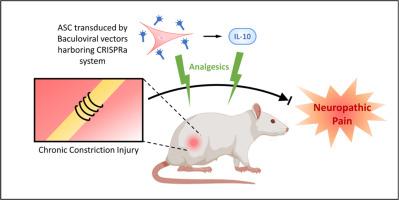通过rna引导基因激活的脂肪源性干细胞减轻神经性疼痛
IF 6.3
3区 工程技术
Q1 ENGINEERING, CHEMICAL
Journal of the Taiwan Institute of Chemical Engineers
Pub Date : 2025-07-24
DOI:10.1016/j.jtice.2025.106304
引用次数: 0
摘要
背景:神经性疼痛影响全球3-10%的人口,但目前的治疗方法不足以提供持续的疼痛缓解。炎症在神经性疼痛中起关键作用,抗炎白细胞介素10 (IL-10)抑制炎症和疼痛。方法scre /loxP系统是一种实现位点特异性DNA重组的遗传工具。在这里,我们开发了一种基于Cre/ loxp的混合杆状病毒系统,通过rna引导CRISPR激活(CRISPRa)来触发脂肪源性干细胞(ASC)中IL-10的表达,希望协同ASC和IL-10的免疫抑制作用来减轻炎症和减轻神经性疼痛。我们构建了一个混合杆状病毒系统,用于将CRISPRa传递到ASC以激活IL-10。我们发现大鼠ASC不自然表达IL-10,但可以通过杆状病毒介导的CRISPRa递送激活,特异性诱导IL-10分泌延长。在ASC中IL-10表达的扩展促进了炎症条件下巨噬细胞由促炎m1样表型向抗炎m2样表型极化,同时抑制促炎肿瘤坏死因子α (TNF-α)/白细胞介素6 (IL-6),上调抗炎IL-10/转化生长因子β1 (TGF-β1)。IL-10在ASC中的激活改善了背根神经节(DRG)神经元的生长,抑制了DRG神经元的体外超敏反应,从第7天开始阻止机械/冷异常痛和热痛觉过敏,并持续至少28天。因此,rna引导激活系统触发ASC中IL-10的表达代表了一种新的持久治疗方法,用于神经性疼痛缓解。本文章由计算机程序翻译,如有差异,请以英文原文为准。

Neuropathic pain attenuation by adipose-derived stem cells engineered with RNA-guided gene activation
Background
Neuropathic pain affects 3-10% of the worldwide population, but current therapies are inadequate to provide sustained pain relief. Inflammation plays key role in neuropathic pain, and anti-inflammatory interleukin 10 (IL-10) represses inflammation and pain.
Methods
Cre/loxP system is a genetic tool that enables site-specific DNA recombination. Here, we developed a hybrid Cre/loxP-based baculovirus system to deliver RNA-guided CRISPR activation (CRISPRa) to trigger IL-10 expression in adipose-derived stem cells (ASC), hoping to synergize the immunosuppressive effects of ASC and IL-10 to mitigate inflammation and attenuate neuropathic pain. We constructed a hybrid baculovirus system for CRISPRa delivery into ASC to activate IL-10.
Significant findings
We showed that rat ASC does not naturally express IL-10 but can be activated by baculovirus-mediated CRISPRa delivery to specifically induce prolonged IL-10 secretion. The extended IL-10 expression in ASC promoted macrophage polarization from pro-inflammatory M1-like towards anti-inflammatory M2-like phenotype under inflammatory conditions, which simultaneously suppressed pro-inflammatory tumor necrosis factor α (TNF-α)/ interleukin 6 (IL-6) and upregulated anti-inflammatory IL-10/transforming growth factor β1 (TGF-β1). The IL-10 activation in ASC improved the dorsal root ganglion (DRG) neuron outgrowth, repressed the hypersensitivity of DRG neurons in vitro, and prevented the mechanical/cold allodynia and heat hyperalgesia starting from day 7 and persisted for at least 28 days. RNA-guided activation system to trigger IL-10 expression in ASC thus represents a new durable therapeutic approach for neuropathic pain relief.
求助全文
通过发布文献求助,成功后即可免费获取论文全文。
去求助
来源期刊
CiteScore
9.10
自引率
14.00%
发文量
362
审稿时长
35 days
期刊介绍:
Journal of the Taiwan Institute of Chemical Engineers (formerly known as Journal of the Chinese Institute of Chemical Engineers) publishes original works, from fundamental principles to practical applications, in the broad field of chemical engineering with special focus on three aspects: Chemical and Biomolecular Science and Technology, Energy and Environmental Science and Technology, and Materials Science and Technology. Authors should choose for their manuscript an appropriate aspect section and a few related classifications when submitting to the journal online.

 求助内容:
求助内容: 应助结果提醒方式:
应助结果提醒方式:


